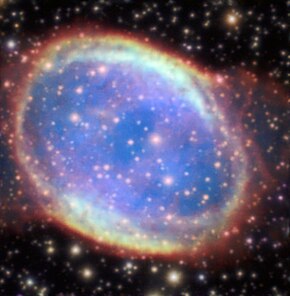| Nebula | |
|---|---|
 | |
| Observation data: J2000 epoch | |
| Right ascension | 18h 12m 02s |
| Declination | -33° 52′ 05″ |
| Apparent magnitude (V) | 10 |
| Apparent dimensions (V) | 0.7′ |
| Constellation | Sagittarius |
NGC 6563 is a planetary nebula in the constellation Sagittarius.[1] NGC 6563 was discovered by Scottish astronomer James Dunlop in 1826. Renowned observer and author Stephen James O'Meara described it as a "hidden treasure".[2]
Morphology
Two fully compatible distances are indicated in the SIMBAD database: 1.665 ± 0.333 kpc (~5430 ly)6 and approximately 1646 pc (~5370 ly). Two identical speed values are also indicated on SIMBAD, −31.0 ± 5.0 km/s. The apparent size of the nebula is 0.8'3 or 0.79'4 (0.795 ± 0.005'), which, taking into account the distance calculations, equates to an actual size of 1, 26 ± 0.26 al. Observations show the expanding CO shell is pretty much continuously distributed around the minor axis waist and the nebula is tilted to the plane of the sky. The shell is also fragmented into a series of condensations.[3]
Central star
The visual magnitude of the central star is 17.49 and its mass is estimated at 2.932 solar masses. Its surface temperature reaches 123 k K and its luminosity is equal to 69 times that of the Sun. The radius of the nebula is estimated at 0.122 pc and its age is equal to 6,350 years.[3]
Gallery
See also
External links
References
- ^ "NGC/IC Project Restoration Efforts". ngcicproject.observers.org. Retrieved 2024-04-22.
- ^ O'Meara, Stephen James (2013-04-08). Deep-Sky Companions: Southern Gems. Cambridge University Press. ISBN 978-1-139-85154-1.
- ^ a b Cox, P.; Huggins, P. J.; Bachiller, R.; Forveille, T. (1991-10-01). "CO in the southern planetary nebulae NGC 6072, NGC 6563, and IC 4406". Astronomy and Astrophysics. 250: 533. Bibcode:1991A&A...250..533C. ISSN 0004-6361.


